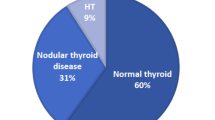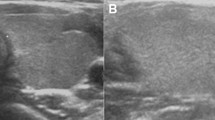Abstract
Objectives: To determine thyroid volume and structure by ultrasound (US) in patients with Turner syndrome (TS) compared to healthy controls; to evaluate the frequency and characteristics of autoimmune thyroid disease (ATD) and its association with clinical and auxological parameters. Patients: 73 patients and 93 height-matched healthy female controls in the same age range were included in the study. Results: Thirty-two TS patients (43.8%) presented ATD. They had a larger body mass index (BMI) and presented the 45,X karyotype more frequently than those without. They were older, with a higher prevalence of lymphoedema at birth and pterygium colli without statistical significance. Thyroid volume was 20% larger in the presence of ATD (p=0.037). A dyshomogeneous thyroid structure was observed in all patients with ATD and less frequently in those without (p=0.016). Dyshomogeneity in TS without ATD was also associated with older age (p<0.001), larger BMI (p=0.003) and larger thyroid volume (p=0.006). Six TS patients presented solitary thyroid nodules (5 benign nodules). We observed a significant interaction between diagnosis and height (p=0.035) and age (p=0.047), indicating that both age and height conditioned the observed differences in thyroid volume. Conclusions: Most TS patients presented ATD with a normal thyroid function or subclinical hypothyroidism, without goiter. Dyshomogeneous thyroid structure was also observed in TS patients without ATD. In TS, the evaluation of thyroid volume according to chronological age does not seem to be efficient because of a link between height and thyroid volume. The prevalence of nodular thyroid disease is similar to that observed in the general population.
Similar content being viewed by others
References
Lippe B. Primary ovarian failure. In Kaplan SA ed. Clinical Pediatric Endocrinology. Philadelphia: W.B. Saunders Company. 1990, 325–66.
Larizza D, Calcaterra V, Martinetti M. Autoimmune stigmata in Turner syndrome: When lacks an X chromosome. J Autoimmun 2009, 33: 25–30.
Radetti G, Mazzanti L, Paganini C, et al. Frequency, clinical and laboratory features of thyroiditis in girls with Turner’s syndrome. The Italian Study Group for Turner’s Syndrome. Acta Paediatrica 1995, 84: 909–12.
Chiovato L, Larizza D, Bendinelli G, et al. Autoimmune hypothyroidism and hyperthyroidism in patients with Turner’s syndrome. Eur J Endocrinol 1996, 134: 568–75.
Pedersen OM, Aardal NP, Larssen TB, Varhaug JE, Myking O, Vik-Mo H. The value of ultrasonography in predicting autoimmune thyroid disease. Thyroid 2000, 10: 251–9.
Rago T, Chiovato L, Grasso L, Pinchera A, Vitti P. Thyroid ultrasonography as a tool for detecting thyroid autoimmune diseases and predicting thyroid dsfunction in apparently healthy subjects. J Endocrinol Invest 2001, 24: 763–9.
Fujimoto Y, Oka A, Omoto R, Hirose M. Ultrasound scanning of the thyroid gland as a new diagnostic approach. Ultrasonics 1967, 5: 177–80.
Tan GH, Gharib H. Thyroid incidentalomas: management approaches to non palpable nodules discovered incidentally on thyroid imaging. Ann Intern Med 1997, 126: 226–31.
Rago T, Vitti P, Chiovato L, et al. Role of conventional ultrasonography and color flow-doppler sonography in predicting malignancy in ‘cold’ thyroid nodules. Eur J Endocrinol 1998, 138: 41–6.
Rago T, Vitti P. Role of thyroid ultrasound in the diagnostic evaluation of thyroid nodules. Best Pract Res Clin Endocrinol Metab 2008, 22: 913–28.
Brunn J, Block U, Ruf G, Bos I, Kunze WP, Scriba PC. Volumetric analysis of thyroid lobes by realtime ultrasound (author’s translation) [in German]. Deutsche medizinische Wochenschrift 1981, 106: 1338–40.
World Health Organization. Indicators for assessing iodine deficiency disorders and their control through salt iodization. Geneva, Switzerland: World Health Organization, 1994 [Document No. WHO/NUT94.6].
[No authors listed] Recommended normative values for thyroid volume in children aged 6–15 years: World Health Organization and International Council for Control of Iodine Deficiency Disorders. Bull WHO 1997, 75: 95–7.
Premawardhana LDKE, Parkes AB, Ammari F, et al. Postpartum thyroiditis and long-term thyroid status: prognostic influence of thyroid peroxidase antibodies and ultrasound echogenicity. J Clin Endocrinol Metab 2000, 85: 71–5.
Elsheikh M, Wass JA, Conway GS. Autoimmune thyroid syndrome in women with Turner’s syndrome — the association with karyotype. Clin Endocrinol (Oxf) 2001, 55: 223–6.
El-Mansoury M, Bryman I, Berntorp K, Hanson C, Wilhelmsen L, Landin-Wilhelmsen K. Hypothyroidism is common in Turner syndrome: results of a five-year follow-up. J Clin Endocrinol Metab 2005, 90: 2131–5.
Marcocci C, Bartalena L, Martino E, Fenzi GF, Pinchera A. Graves’ disease and Turner’s syndrome. J Endocrinol Invest 1980, 3: 429–31.
de Kerdanet M, Lucas J, Lemee F, Lecornu M. Turner’s syndrome with X-isochromosome and Hashimoto’s thyroiditis. Clin Endocrinol (Oxf) 1994, 41: 673–6.
Elsheikh M, Dunger DB, Conway GS, Wass JA. Turner’s syndrome in adulthood. Endocr Rev 2002, 23: 120–40.
Germain EL, Plotnick LP. Age-related anti-thyroid antibodies and thyroid abnormalities in Turner syndrome. Acta Paediatr Scand 1986, 75: 750–5.
Livadas S, Xekouki P, Fouka F, et al. Prevalence of thyroid dysfunction in Turner’s syndrome: a long term follow-up study and brief literature review. Thyroid 2005, 15: 1061–6.
Bachrach LK, Daneman D, Daneman A, Martin DJ. Use of ultrasound in childhood thyroid disorders. J Pediatr 1983, 103: 547–52.
Berghout A, Wiersinga WM, Smits NJ, Touber JL. Determinants of thyroid volume as measured by ultrasonography in healthy adults in a non-iodine deficient area. Clin Endocrinol (Oxf) 1987, 26: 273–80.
Ivarsson SA, Ericsson UB, Fredriksson B, Persson PH. Ultrasonic imaging in the differential diagnosis of diffuse thyroid disorders in children. Am J Dis Child 1989, 143: 1369–72.
Hegedüs L, Perrild H, Poulsen LR, et al. The determination of thyroid volume by ultrasound and its relationship to body weight, age, and sex in normal subjects. J Clin Endocrinol Metab 1983, 56: 260–3.
Ivarsson SA, Persson PH, Ericsson UB. Thyroid gland volume as measured by ultrasonography in healthy children and adolescents in a non-iodine deficient area. Acta Paediatr Scand 1989, 78: 633–4.
Zimmermann MB, Hess SY, Molinari L, et al. New reference values for thyroid volume by ultrasound in iodine-sufficient schoolchildren: a World Health Organization/Nutrition for Health and Development Iodine Deficiency Study Group Report. Am J Clin Nutr 2004, 79: 231–7.
Zimmermann MB, Molinari L, Spehl M, et al. Toward a consensus on reference values for thyroid volume in iodine-replete schoolchildren: results of a workshop on inter-observer and inter-equipment variation in sonographic measurement of thyroid volume. Eur J Endocrinol 2001, 144: 213–20.
Fleury Y, Van Melle G, Woringer V, Gaillard RC, Portmann L Sex-dependent variations and timing of thyroid growth during puberty. J Clin Endocrinol Metab 2001, 86: 750–4.
Wiersinga WM, Podoba J, Srbecky M, van Vessem M, van Beeren HC, Platvoet-Ter Schiphorst MC. A survey of iodine intake and thyroid volume in Dutch schoolchildren: reference values in an iodine-sufficient area and the effect of puberty. Eur J Endocrinol 2001, 144: 595–603.
Bürgi H, Portmann L, Podoba J, Vertongen F, Srbecky M. Thyroid volumes and urinary iodine in Swiss school children, 17 years after improved prophylaxis of iodine deficiency. Eur J Endocrinol 1999, 140: 104–6.
Delange F, Benker G, Caron P, et al. Thyroid volume and urinary iodine in European schoolchildren: standardization of values for assessment of iodine deficiency. Eur J Endocrinol 1997, 136: 180–7.
Kaloumenou I, Alevizaki M, Ladopoulos C, et al. Thyroid volume and echostructure in schoolchildren living in an iodine-replete area: relation to age, pubertal stage, and body mass index. Thyroid 2007, 17: 875–81.
Vitti P, Rago T. Thyroid ultrasound as a predicator of thyroid disease. J Endocrinol Invest 2003, 26: 686–9.
Radetti G, Kleon W, Buzi F, et al. Thyroid function and structure in childhood obesity. J Clin Endocrinol Metab 2008, 93: 4749–54.
Clark EB. Neck web and congenital heart defects: a pathogenic association in 45 X-O Turner syndrome? Teratology 1984, 29: 355–61.
Loscalzo ML, Van PL, Ho VB, et al. Association between fetal lymphedema and congenital cardiovascular defects in Turner syndrome. Pediatrics 2005, 115: 732–5.
Lacro RV, Jones KL, Benirschke K. Coarctation of the aorta in Turner syndrome: a pathologic study of fetuses with nuchal cystic hygromas, hydrops fetalis, and female genitalia. Pediatrics 1988, 81: 445–51.
Miyabara S, Sugihara H, Maehara N, et al. Significance of cardiovascular malformations in cystic hygroma: a new interpretation of the pathogenesis. Am J Med Genet 1989, 34: 489–501.
Lippe B. The thyroid. In Kaplan SA ed. Clinical Pediatric Endocrinology. Philadelphia: W.B. Saunders Company. 1990, 87–126.
Gillam MP, Kopp P. Genetic regulation of thyroid development. Curr Opin Pediatr 2001, 13: 358–63.
Schoemaker MJ, Swerdlow AJ, Higgins CD, Wright AF, Jacobs PA; UK Clinical Cytogenetics Group. Cancer incidence in women with Turner syndrome in Great Britain: a national cohort study. Lancet Oncol 2008, 9: 239–46.
Dean DS, Gharib H. Epidemiology of thyroid nodules. Best Pract Res Clin Endocrinol Metab 2008, 22: 901–11.
Kim DL, Song KH, Kim SK. High prevalence of carcinoma in ultrasonography-guided fine needle aspiration cytology of thyroid nodules. Endocr J 2008, 55: 135–42.
Benvenga S. Update on thyroid cancer. Horm Metab Res 2008, 40: 323–8.
Author information
Authors and Affiliations
Corresponding author
Rights and permissions
About this article
Cite this article
Calcaterra, V., Klersy, C., Muratori, T. et al. Thyroid ultrasound in patients with Turner syndrome: Influence of clinical and auxological parameters. J Endocrinol Invest 34, 260–264 (2011). https://doi.org/10.1007/BF03347082
Accepted:
Published:
Issue Date:
DOI: https://doi.org/10.1007/BF03347082




